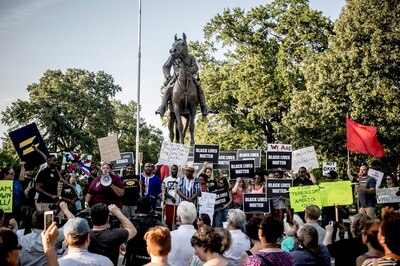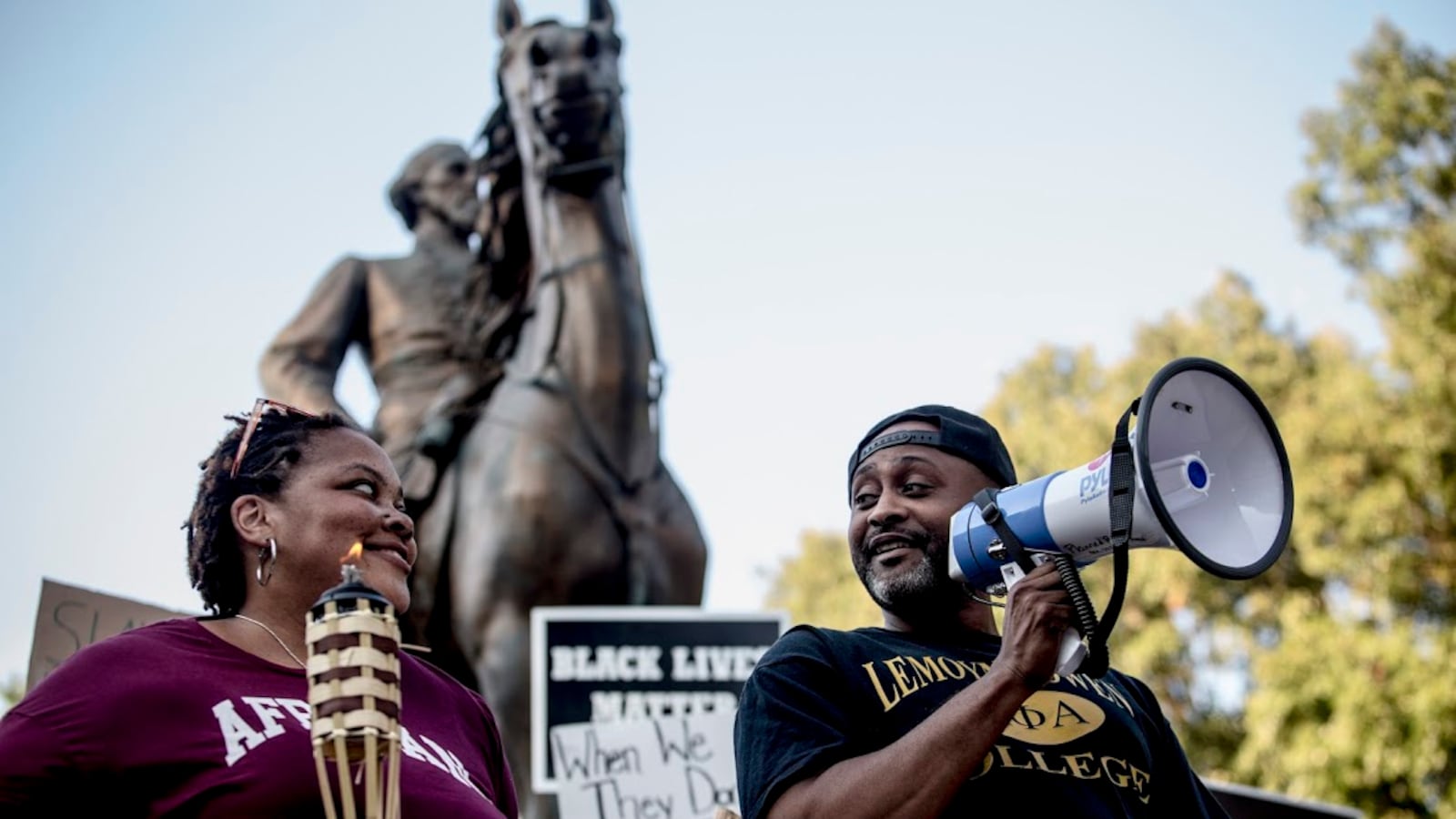UPDATE: On Dec. 20, the Memphis City Council voted to transfer ownership of the city’s two Confederate monuments to a nonprofit, which allowed for the removal of both the Nathan Bedford Forest and Jefferson Davis monuments from public parks. Read more here.
Hours after white supremacists marched in Charlottesville, Tami Sawyer’s phone was abuzz.
Some Memphis teachers wanted to talk over their plans to discuss the weekend’s violence with their students. She was also fielding questions from local news outlets about efforts to remove Memphis’ own Confederate statues — the issue that drew white supremacists to the Virginia college town.
The first messages were part of Sawyer’s role at Teach for America, where she serves as the local director of diversity and cultural competence. The others came out of her own activism — and her flurry of responses illustrate what life looks like for many educators stepping outside of the classroom to advocate for social justice.
“It’s a constant wheel,” she said. “I will go to bed probably about 1 a.m. because I stay up on social media and firing off emails and I wake up and I do it all over again tomorrow.”
Sawyer, a 35-year-old Memphis native, is the face of #takeemdown901, the newest campaign to remove two Confederate monuments from parks in downtown Memphis.
It’s a messy fight: The city owns the land, but can’t remove the statues on its own. State officials, angered by a 2015 Memphis city council vote to remove one, took control over what the city can do with its monuments.
And though the city has vowed to sue the state if it blocks the removal of the other monument, Sawyer and others aren’t satisfied with that pace.
“Jefferson Davis is known to have said that it is the duty of the white Christian man to own black people because they are unintelligent,” Sawyer said. “So, why is it important for me? It’s because a man that told me that I was dumb and needed to be picking his cotton can’t stand in my city. My nieces can’t come up under that shadow.”
But the fight against the Confederate monuments is just the latest facet of a longer, and personal, campaign for Sawyer.
She grew up in Memphis and went to St. Mary’s Episcopal, a private school. After graduating from the University of Memphis and spending about a year in law school at Howard University, Sawyer worked for U.S. Navy in Washington focusing on diversity hiring practices.
She returned to Memphis in 2013, as the uproar surrounding the merger and subsequent de-merger of its suburban and city schools was at its height. But local activism, she thought, seemed to be too much talk and too little action.
When 18-year-old Michael Brown was killed in Ferguson, Missouri in 2014, she decided to organize a local protest.
“Next thing I knew, I had a lot to say and people listened,” she said. “And I didn’t know what to do with that except to keep talking and keep organizing.”

In 2015, Sawyer organized a vigil for a black Memphis teen, Darrius Stewart, who was killed by a white police officer. About 200 people gathered, including a large contingent of Teach for America teachers.
TFA teachers “came of their own accord,” Sawyer recalled, “and that was just impressive to me.”
Earle Fisher, a Memphis pastor and activist who is always within arm’s length of Sawyer at rallies or press conferences, noted that day was when the two “met on the battlefield.”
“As has been the case ever since, she was directing me on how things were meant to go at the rally she had organized,” he said. “There’s a reason we call her Tami Lou Hamer.”
Soon after that vigil, Sawyer joined TFA, overhauling the local chapter’s curriculum to help teachers understand how racism and poverty affect their students and their community.
Teach For America is not affiliated with Sawyer’s activism, but her work to remove statues of Jefferson Davis and Nathan Bedford Forrest is in keeping with organization’s recent efforts to connect more with the black and Hispanic communities they serve in.
Athena Turner, the group’s executive director in Memphis, came to the city 11 years ago when 85 percent of the city’s public school students were black and 88 percent of the TFA teachers working in the city were white. Now, about half of TFA teachers are people of color.
“From when I was a corps member to now, the organization has gotten a lot more explicit about the ways in which our commitments and values of diversity and equity and inclusion play out in all aspects of our work,” Turner said. Sawyer’s work, she said, “demonstrates those values pretty explicitly.”
TFA, like many other education organizations, has also grappled with how to help teachers address racism in the classroom in the years following the death of Trayvon Martin, the Florida teenager killed in 2012. The organization has deep ties to the Black Lives Matter movement that has emerged since: Prominent activists, including DeRay Mckesson and Brittany Packnett, were TFA teachers and later worked for the teacher training organization.
Sawyer herself sees helping teachers understand students’ culture and the broader fight for equity in Memphis as deeply connected. That desire fueled her decision to run, unsuccessfully, for state representative last year.
More recently, just after Sawyer launched an online petition to remove the Confederate statue — a petition that came out of a goal-setting exercise at a TFA summer staff retreat — Sawyer spoke to a group of students at GRAD Academy, a local charter school.
The conversation quickly turned from issues in the classroom to problems in their city.
“I told them you have to self-advocate,” Sawyer recalled. “And then someone said, ‘Is that what you’re doing with these statues?’ And I said yes. We have to advocate for ourselves. No one is going to take these statues down for us, right?”
The next week, several teens from that program showed up at a community meeting she organized.
“I don’t understand why we still have statues of people who didn’t want us to be anything,” 15-year-old Beyonce Cox said. “They didn’t want us African-Americans to have power, they wanted us to stay down.”
Helping students gain that sense of citizenship and agency — for Sawyer, that’s the point of her work.
“You raise an engineer in South Memphis who can figure out how to run a metro through Memphis because he’s going to remember how his mom and grandma couldn’t get around and carrying groceries in the rain,” she said.
“In the grand scheme of things, taking down the statues won’t change transportation. It won’t change access to fresh foods or economic justice. But it will teach us how to advocate for ourselves.”

